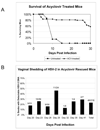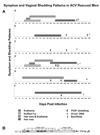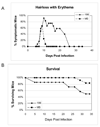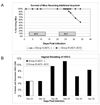Recurrent vaginal shedding of herpes simplex type 2 virus in the mouse and effects of antiviral therapy
- PMID: 20167236
- PMCID: PMC2878486
- DOI: 10.1016/j.antiviral.2010.02.317
Recurrent vaginal shedding of herpes simplex type 2 virus in the mouse and effects of antiviral therapy
Abstract
A mouse model of recurrent herpes simplex type 2 (HSV-2) would improve our understanding of the immunobiology of recurrent disease and provide a useful model for evaluating antiviral treatments. We developed a model to evaluate recurrent vaginal HSV-2 shedding using high-dose acyclovir (ACV) therapy beginning at 3 days post infection (dpi). Treatment with 150mg/kg of ACV for 10 days increased survival to 80% following vaginal challenge with HSV-2 strain 186 and to 100% after challenge with strain MS. We then evaluated recurrent vaginal HSV-2 shedding in surviving mice. Although infectious virus was not detected in vaginal samples after 21dpi, viral DNA was detectable by PCR in 80% of mice (47/59) on at least 1 day, while no animal was positive for virus on every day. ACV therapy administered from day 21 to 31 significantly reduced recurrent virus shedding during this period from 7.3% (8/109 swabs) to 0.8% (1/126 swabs) (p=0.013). Lastly, ACV-rescued HSV-2-infected mice treated with cyclophosphamide at 35 and 38dpi rapidly succumbed, indicating that this model can be used to study immune control of the persistent infection. Thus, this model provides an inexpensive model for evaluating therapeutic strategies and immune control of persistent HSV.
Figures







Similar articles
-
One-day regimen of valacyclovir for treatment of recurrent genital herpes simplex virus 2 infection.Sex Transm Dis. 2008 Apr;35(4):383-6. doi: 10.1097/OLQ.0b013e31815e4190. Sex Transm Dis. 2008. PMID: 18362859
-
Frequent genital herpes simplex virus 2 shedding in immunocompetent women. Effect of acyclovir treatment.J Clin Invest. 1997 Mar 1;99(5):1092-7. doi: 10.1172/JCI119237. J Clin Invest. 1997. PMID: 9062368 Free PMC article. Clinical Trial.
-
Efficacy of N-methanocarbathymidine against genital herpes simplex virus type 2 shedding and infection in guinea pigs.Antivir Chem Chemother. 2015 Feb;24(1):19-27. doi: 10.1177/2040206614566581. Antivir Chem Chemother. 2015. PMID: 26149263 Free PMC article.
-
HSV shedding.Antiviral Res. 2004 Aug;63 Suppl 1:S19-26. doi: 10.1016/j.antiviral.2004.06.004. Antiviral Res. 2004. PMID: 15450382 Review.
-
Herpes simplex virus: the importance of asymptomatic shedding.J Antimicrob Chemother. 2000 Apr;45 Suppl T3:1-8. doi: 10.1093/jac/45.suppl_4.1. J Antimicrob Chemother. 2000. PMID: 10855766 Review.
Cited by
-
Genital herpes simplex virus type 2 infection in humanized HIV-transgenic mice triggers HIV shedding and is associated with greater neurological disease.J Infect Dis. 2014 Feb 15;209(4):510-22. doi: 10.1093/infdis/jit472. Epub 2013 Aug 29. J Infect Dis. 2014. PMID: 23990571 Free PMC article.
-
Proteomic characterization of acyclovir-induced nephrotoxicity in a mouse model.PLoS One. 2014 Jul 23;9(7):e103185. doi: 10.1371/journal.pone.0103185. eCollection 2014. PLoS One. 2014. PMID: 25055032 Free PMC article.
-
A lentiviral vector-based, herpes simplex virus 1 (HSV-1) glycoprotein B vaccine affords cross-protection against HSV-1 and HSV-2 genital infections.J Virol. 2012 Jun;86(12):6563-74. doi: 10.1128/JVI.00302-12. Epub 2012 Apr 4. J Virol. 2012. PMID: 22491465 Free PMC article.
References
-
- Centifanto-Fitzgerald Y, Caldwell DR, Yates F. Herpes simplex virus: recurrent and nonrecurrent strains. Proc Soc Exp Biol Med. 1987;185:484–492. - PubMed
-
- Efstathiou S, Field HJ, Griffiths PD, Kern ER, Sacks SL, Sawtell NM, Stanberry LR. Herpes simplex virus latency and nucleoside analogues. Antiviral Res. 1999;41:85–100. - PubMed
Publication types
MeSH terms
Substances
Grants and funding
LinkOut - more resources
Full Text Sources
Other Literature Sources
Medical

